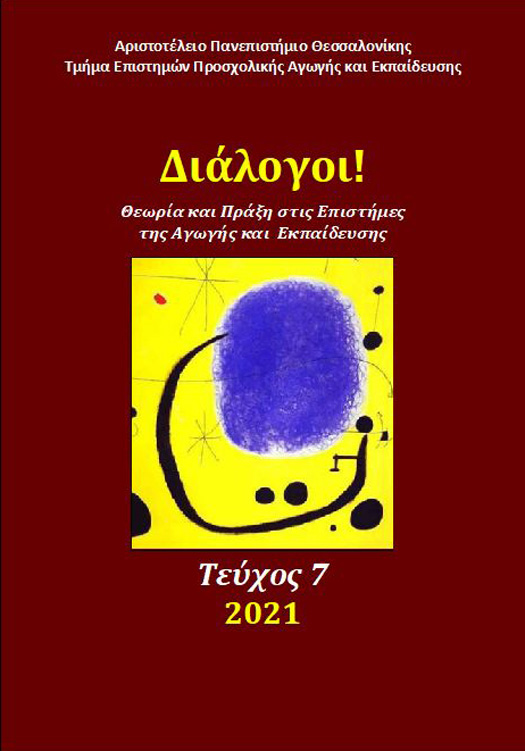Οι τρόποι σκέψης στο μοντέλο της Binkley και η ενίσχυσή τους μέσα από το ερευνητικό/παρεμβατικό πρόγραμμα «Δημιουργική Γραφή και Δεξιότητες Κοινωνικής Μάθησης» στο δημοτικό σχολείο

Περίληψη
Η Binkley και οι συνεργάτες της στο μοντέλο που παρουσίασαν για τις δεξιότητες του 21ου αιώνα, τις οποίες πολλοί ταυτίζουν με τις κοινωνικές δεξιότητες, αναφέρουν ότι στους τρόπους σκέψης ανήκουν η συγκλίνουσα/αποκλίνουσα σκέψη, η καινοτομία/δημιουργικότητα και η μεταγνώση. Το ερευνητικό/παρεμβατικό πρόγραμμα «Δημιουργική Γραφή και Δεξιότητες Κοινωνικής Μάθησης» του τμήματος Βαλκανικών, Σλαβικών και Ανατολικών Σπουδών του Πανεπιστημίου Μακεδονίας, διάρκειας πέντε μηνών περίπου, διερευνά την ενίσχυση των παραπάνω δεξιοτήτων, οι οποίες αποτελούν μέρος ενός ευρύτερου συνόλου κοινωνικών δεξιοτήτων που σχετίζονται με τη μάθηση, έχοντας ως εκπαιδευτικό εργαλείο τη δημιουργική γραφή και αφόρμηση λογοτεχνικά κείμενα των βαλκανικών χωρών. Το δείγμα της έρευνας αποτέλεσαν 573 μαθητές της Ε΄ και ΣΤ΄ τάξης των δημοτικών σχολείων του νομού Θεσσαλονίκης, οι οποίοι χωρίστηκαν στην Ομάδα Παρέμβασης, που υλοποίησε το πρόγραμμα και στην Ομάδα Ελέγχου, που παρακολούθησε το κανονικό της πρόγραμμα. Η διερεύνηση του επιπέδου των δεξιοτήτων κοινωνικής μάθησης των παιδιών έγινε με τη χρήση ενός δομημένου αυτοσχέδιου ερωτηματολογίου, του οποίου οι συντελεστές αξιοπιστίας alpha Cronbach κυμαίνονται σε πολύ υψηλά επίπεδα. Η ανάλυση των αποτελεσμάτων κατέδειξε ότι η Ομάδα Παρέμβασης σημείωσε στατιστικά σημαντική μεγαλύτερη βελτίωση στην αξιολόγηση των παραπάνω δεξιοτήτων σε σχέση με την Ομάδα Ελέγχου και με εξισωμένα τα δημογραφικά και άλλα στοιχεία των μαθητών.
Λεπτομέρειες άρθρου
- Πώς να δημιουργήσετε Αναφορές
-
Τσάτσου-Νικολούλη Σ., Μαυρογένη Σ., Κωτόπουλος Τ., & Αλευριάδου Α. (2021). Οι τρόποι σκέψης στο μοντέλο της Binkley και η ενίσχυσή τους μέσα από το ερευνητικό/παρεμβατικό πρόγραμμα «Δημιουργική Γραφή και Δεξιότητες Κοινωνικής Μάθησης» στο δημοτικό σχολείο. Διάλογοι! Θεωρία και πράξη στις επιστήμες αγωγής και εκπαίδευσης, 7, 79–113. https://doi.org/10.12681/dial.25862
- Τεύχος
- Τόμ. 7 (2021)
- Ενότητα
- Επιστημονική Αρθογραφία

Αυτή η εργασία είναι αδειοδοτημένη υπό το CC Αναφορά Δημιουργού – Μη Εμπορική Χρήση – Παρόμοια Διανομή 4.0.
Οι συγγραφείς των άρθρων που δημοσιεύονται στο Διάλογοι! Θεωρία και Πράξη στις Επιστήμες Αγωγής και Εκπαίδευσης διατηρούν τα δικαιώματα πνευματικής ιδιοκτησίας επί των άρθρων τους, δίνοντας στο περιοδικό το δικαίωμα της πρώτης δημοσίευσης. Άρθρα που δημοσιεύονται στο Διάλογοι! Θεωρία και Πράξη στις Επιστήμες της Αγωγής και Εκπαίδευσης διατίθενται με άδεια Creative Commons 4.0 και σύμφωνα με την άδεια μπορούν να χρησιμοποιούνται ελεύθερα, με αναφορά στον/στη συγγραφέα και στην πρώτη δημοσίευση για μη κερδοσκοπικούς σκοπούς και με δικαίωμα τροποποίησης μόνον με παρόμοια διανομή (αν αναμείξετε, τροποποιήσετε, ή δημιουργήσετε πάνω στο υλικό, πρέπει να διανείμετε τις δικές σας συνεισφορές υπό την ίδια άδεια όπως και το πρωτότυπο).
To Τμήμα Επιστημών Προσχολικής Αγωγής και Εκπαίδευσης του Αριστοτέλειου Πανεπιστημίου Θεσσαλονίκης και το Εθνικό Κέντρο Τεκμηρίωσης διατηρούν το δικαίωμα να δημοσιεύουν, να αναπαραγάγουν, να παρουσιάζουν στο κοινό, να διανέμουν και να χρησιμοποιούν άρθρα που δημοσιεύονται στο Διάλογοι! Θεωρία και Πράξη στις Επιστήμες Αγωγής και Εκπαίδευσης σε οποιοδήποτε μέσο και μορφή είτε μεμονωμένα είτε ως μέρη συλλογικών έργων, για όλο το χρόνο διάρκειας προστασίας της πνευματικής ιδιοκτησίας και για όλες τις χώρες του κόσμου.
Αυτό περιλαμβάνει ενδεικτικά, και όχι αποκλειστικά, το δικαίωμα δημοσίευσης των άρθρων σε τεύχη του περιοδικού Διάλογοι! Θεωρία και Πράξη στις Επιστήμες Αγωγής και Εκπαίδευσης, αναπαραγωγής και διανομής μεμονωμένων αντιγράφων των άρθρων, αναπαραγωγής ολόκληρων των άρθρων σε άλλη έκδοση του Τμήματος Επιστημών Προσχολικής Αγωγής και Εκπαίδευσης του Αριστοτέλειου Πανεπιστημίου Θεσσαλονίκης και του Εθνικού Κέντρου Τεκμηρίωσης και αναπαραγωγής και διανομής των άρθρων ή περίληψης αυτών με χρήση πληροφορικού συστήματος αποθετηρίου.


